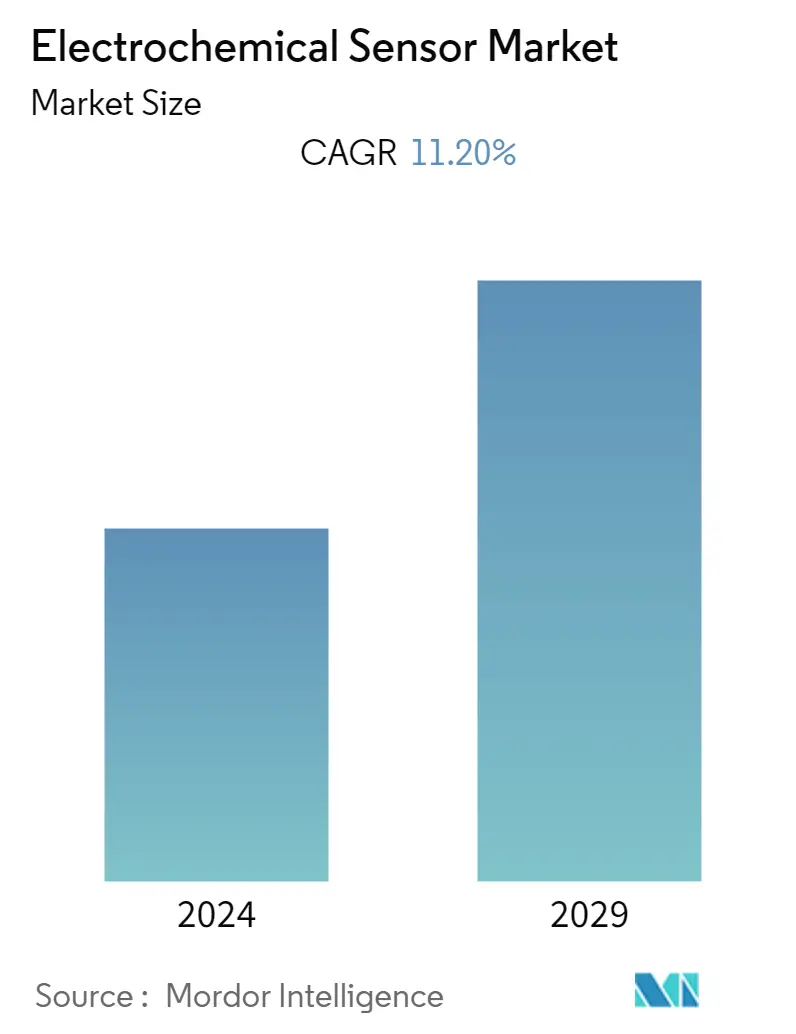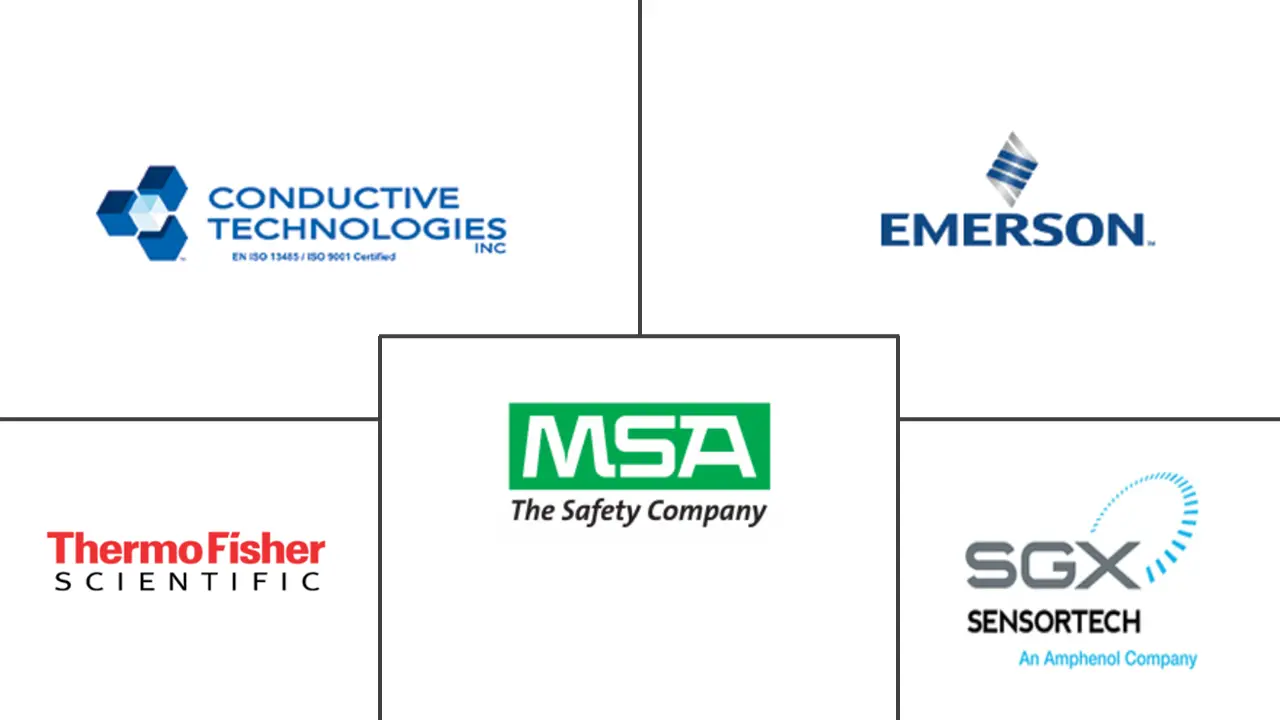Market Size of Electrochemical Sensor Industry

| Study Period | 2019 - 2029 |
| Base Year For Estimation | 2023 |
| CAGR | 11.20 % |
| Fastest Growing Market | Asia Pacific |
| Largest Market | North America |
| Market Concentration | Low |
Major Players
*Disclaimer: Major Players sorted in no particular order |
Electrochemical Sensor Market Analysis
The Global Electrochemical Sensor Market is expected to register a CAGR of 11.2% during the forecast period. The market has been buoyed by the advent of MEMS technology, miniaturization of gas detection circuitry, and the development of solid-state sensors that have increased the popularity of sensor modules to detect gases.
- Increasing focus on the safety of hazardous locations due to the rise in the number of explosions occurring in the extreme environment of the manufacturing and chemical industries because of the presence of toxic and combustible gases has prompted an increased focus on explosion prevention through implicit monitoring across the hazardous zones of these end-user industries to achieve a safer working environment.
- The automotive sector has witnessed favorable gains, primarily driven by emerging applications such as cabin air quality and fuel emission detectors. Aligning trends such as improving fuel efficiency and air quality control has been a significant driver for the electrochemical-based gas sensor market.
- Furthermore, government regulations, such as COSHH and OSHA regulations, toward offshore oil and gas exploration and production, and storage activities, impose strict limits on the exposure to carbon monoxide and other toxic gases fumes. This has been a significant driver for the adoption of electrochemical technology-based gas sensors.
- Medical and diagnostics are lucrative market segments driven by a strong interest in fast point-of-care testing and monitoring devices. Furthermore, the integration of bio-sensors into multiple diagnostic medical equipment is set to offer a plethora of opportunities for the market over the forecast period.
- Further, the vendors in the studied market are constantly innovating and offering new solutions. For instance, in July 2021, DropSens, a Metrohm company, unveiled new capabilities that will make mass production of customized electrochemical sensors easier. Custom sensors are made using a highly scalable and cost-effective manufacturing technique that has almost no quantity restrictions. From original concept to in-depth prototype design, Metrohm DropSens covers the whole development and manufacturing process.
- Moreover, in March 2021, for industrial safety applications, DD-Scientific introduced a new line of high-performance electrochemical gas sensors. The DceL suite of solutions not only provides industry-leading robustness and performance for dangerous gas and oxygen monitoring, but they also come in an ultra-compact design that allows for detector size reduction. Sensors for the most routinely measured hazardous species, such as hydrogen sulfide, carbon monoxide, nitrogen dioxide, ammonia, and Sulphur dioxide, are available in the DceL range.
- The outbreak of the COVID-19 pandemic caused by a novel severe acute respiratory syndrome coronavirus 2 (SARS-CoV-2) posed a threat to public health worldwide. Thus, the development of a rapid, accurate, and easy-to-implement diagnostic system for virus detection became crucial for controlling the infection sources and monitoring the illness progression.
- In June 2020, the Northeastern University College of Engineering Professor Nian Sun was awarded a USD 200,000 NSF RAPID grant for the COVID-19 new handheld gas sensor for Airborne SARS-CoV-2 Virus instant COVID-19 diagnosis from exhaled breath. In collaboration with Jeremy Luban from UMass Medical School, the project aims to streamline the COVID-19 detection and diagnosis process. Both professors developed a handheld gas sensor for the SARS-CoV-2 virus in air detection, using each of their fields of expertise.
Electrochemical Sensor Industry Segmentation
The Global Electrochemical Sensor Market is segmented by Type (Potentiometric Sensors, Amperometric Sensors, Conductometric Sensors), by End-user Industry (Oil and Gas, Chemical and Petrochemicals, Medical, Automotive, Food & Beverages), and by Geography. Electrochemical sensors are unique due to their ability to monitor toxic and non-toxic gases to withstand high humidity and temperature. These sensors are majorly used in industrial environments where the monitoring of hydrogen sulfide, carbon monoxide, and other industrial gases is a critical safety requirement.
| By Type | |
| Potentiometric Sensors | |
| Amperometric Sensors | |
| Conductometric Sensors |
| By End-user Industry | |
| Oil and Gas | |
| Chemical and Petrochemicals | |
| Medical | |
| Automotive | |
| Food & Beverage | |
| Other End-user Industry |
| By Geography | |
| North America | |
| Europe | |
| Asia Pacific | |
| Latin America | |
| Middle East and Africa |
Electrochemical Sensor Market Size Summary
The global electrochemical sensor market is experiencing significant growth, driven by advancements in MEMS technology, miniaturization of gas detection circuitry, and the development of solid-state sensors. These innovations have enhanced the popularity of sensor modules for gas detection, particularly in hazardous environments such as manufacturing and chemical industries, where the focus on explosion prevention is paramount. The automotive sector is also contributing to market expansion through applications like cabin air quality and fuel emission detection, aligning with trends in fuel efficiency and air quality control. Regulatory frameworks, such as COSHH and OSHA, are further propelling the adoption of electrochemical sensors, especially in offshore oil and gas operations, by imposing strict limits on exposure to toxic gases. The medical and diagnostics segments are witnessing lucrative opportunities due to the demand for rapid point-of-care testing and the integration of biosensors into diagnostic equipment.
North America stands as a significant market for electrochemical sensors, fueled by extensive R&D activities in various sectors, including biomedical and automotive industries. The region's market is bolstered by advancements in smart city initiatives and the growing production of light vehicles, which emphasize fuel efficiency and performance. The increasing incidence of industrial explosions has led to stricter safety regulations, further driving the demand for electrochemical gas sensors. The competitive landscape of the market is marked by the presence of both small and large players, with companies like Thermo Fisher Scientific and Emerson Electric Co. actively engaging in partnerships and product innovations to enhance their market share. The consumer segment, although small, is rapidly growing, with developments in MEMS technologies enabling the creation of cost-effective, compact sensors for various applications.
Electrochemical Sensor Market Size - Table of Contents
-
1. MARKET INSIGHTS
-
1.1 Market Overview
-
1.2 Industry Attractiveness - Porter's Five Forces Analysis
-
1.2.1 Bargaining Power of Suppliers
-
1.2.2 Bargaining Power of Consumers
-
1.2.3 Threat of New Entrants
-
1.2.4 Threat of Substitutes
-
1.2.5 Intensity of Competitive Rivalry
-
-
1.3 Impact of COVID-19 on the Electrochemical Sensor Market
-
-
2. MARKET SEGMENTATION
-
2.1 By Type
-
2.1.1 Potentiometric Sensors
-
2.1.2 Amperometric Sensors
-
2.1.3 Conductometric Sensors
-
-
2.2 By End-user Industry
-
2.2.1 Oil and Gas
-
2.2.2 Chemical and Petrochemicals
-
2.2.3 Medical
-
2.2.4 Automotive
-
2.2.5 Food & Beverage
-
2.2.6 Other End-user Industry
-
-
2.3 By Geography
-
2.3.1 North America
-
2.3.2 Europe
-
2.3.3 Asia Pacific
-
2.3.4 Latin America
-
2.3.5 Middle East and Africa
-
-
Electrochemical Sensor Market Size FAQs
What is the current Electrochemical Sensor Market size?
The Electrochemical Sensor Market is projected to register a CAGR of 11.20% during the forecast period (2024-2029)
Who are the key players in Electrochemical Sensor Market?
Conductive Technologies Inc., Emerson Electric Co., Thermo Fisher Scientific, MSA and SGX Sensortech are the major companies operating in the Electrochemical Sensor Market.

